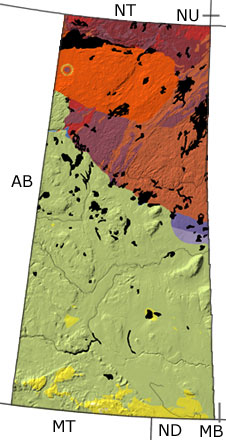

Saskatchewan, Canada |
|||||||||||||||||||||||||||||||||||||||||||||||||||||||||||||||
|
|||||||||||||||||||||||||||||||||||||||||||||||||||||||||||||||
Paleontology and geologyThe Precambrian: Saskatchewan formed in the Precambrian when several older continents came together about 1.85 Ga. This collision created a huge mountain range over most of the province, which has been eroding every since. Ancient islands, volcanoes, and oceans are also represented in these igneous, sedimentary, and metamorphic rocks. Sandstones and limestones in the northwest accumulated in a basin along the edge of the continent, and these deposits contain stromatolite fossils and economically important minerals. The Paleozoic: Through much of the early Paleozoic, the southern half of Saskatchewan was covered by shallow seas. The seas filled with sediments eroding from the Precambrian rocks to the north and east. In the warm, tropical waters, corals built up reefs, which were home to a variety of invertebrates such as brachiopods, trilobites, bivalves, snails, and cephalopods. Toward the end of the era, the seas began to retreat. In some areas, evaporating seawater left deposits like salt, gypsum, and potash. Most of these rocks are buried beneath the surface under younger rocks, but a few exposures can be found in the east and west. The Mesozoic: In the early Mesozoic, Saskatchewan was above sea level, and reddish-colored sandstones were deposited in river valleys and lowlands. By the middle of this era, the shallow seas of the Western Interior Seaway encroached on the land. A wide diversity of invertebrates could be found in the seas, as well as sharks, crocodiles, and giant marine reptiles. At the end of the Mesozoic, the seas were replaced by forests and lakes and the animal life included many different dinosaurs, reptiles, and early birds and mammals. The Cenozoic: In the early Cenozoic, a warm, humid climate prevailed over Saskatchewan, which was covered by forests and swamps. Turtles, crocodiles, fish, and early mammals filled these habitats. As the climate began to cool toward the end of the Cenozoic, the swamps were replaced by savannas and grasslands, and the fauna changed to include grazing and browsing animals. Eventually, glaciers spread down from the north, creating the present landscape of the province. Lakes formed by melting ice left the silt and clay deposits that are currently used for agriculture. They also preserved fossils of many different Ice Age animals. |
|||||||||||||||||||||||||||||||||||||||||||||||||||||||||||||||
Links to more on Saskatchewan paleontology |
|||||||||||||||||||||||||||||||||||||||||||||||||||||||||||||||
|
Organizations | Education and Exhibits | Resources OrganizationsEducation and Exhibits Resources
|
|||||||||||||||||||||||||||||||||||||||||||||||||||||||||||||||
|
site tour |
about the site |
site map |
site credits |
page credits |
help |
FAQs |
contact |
||

